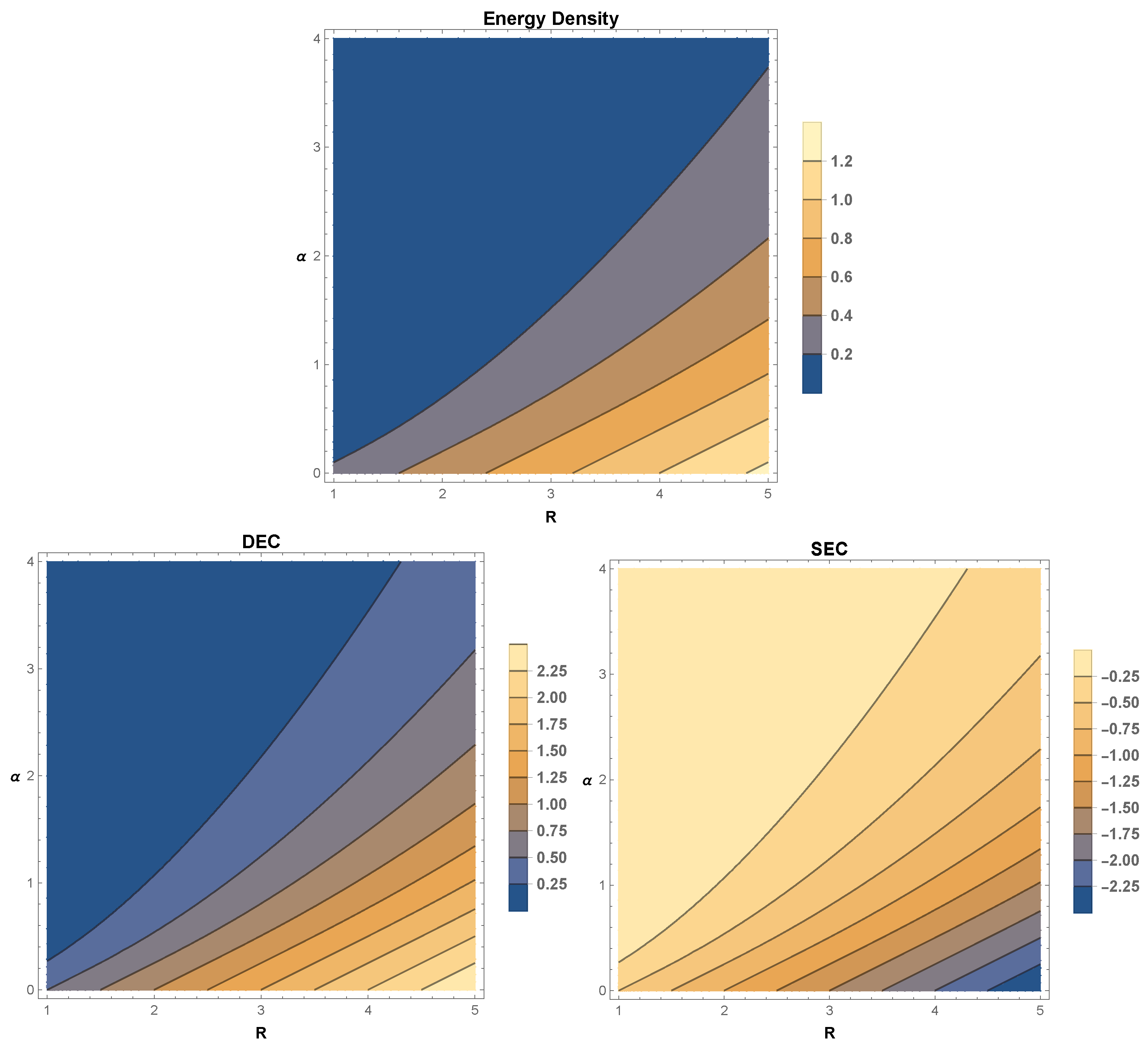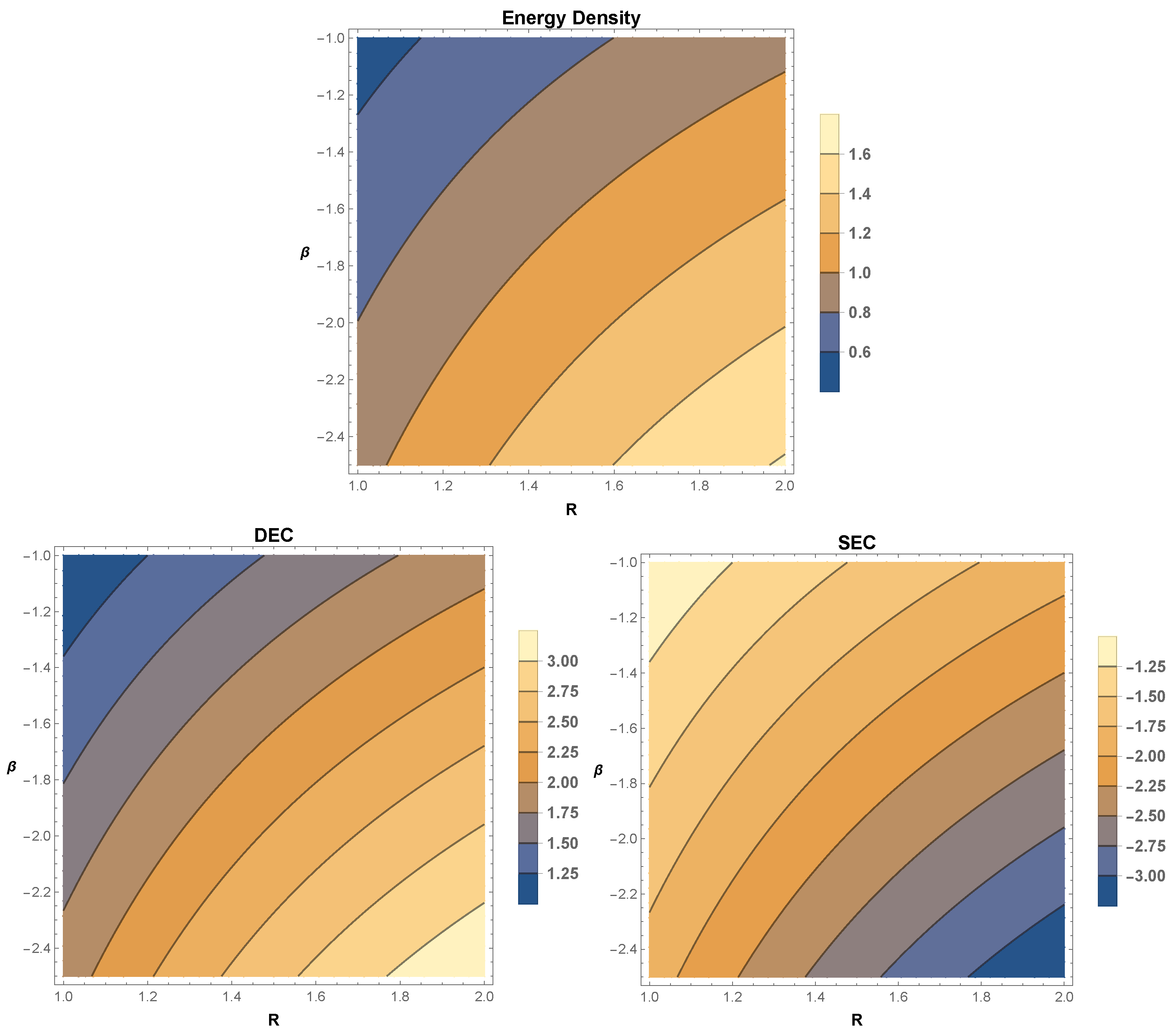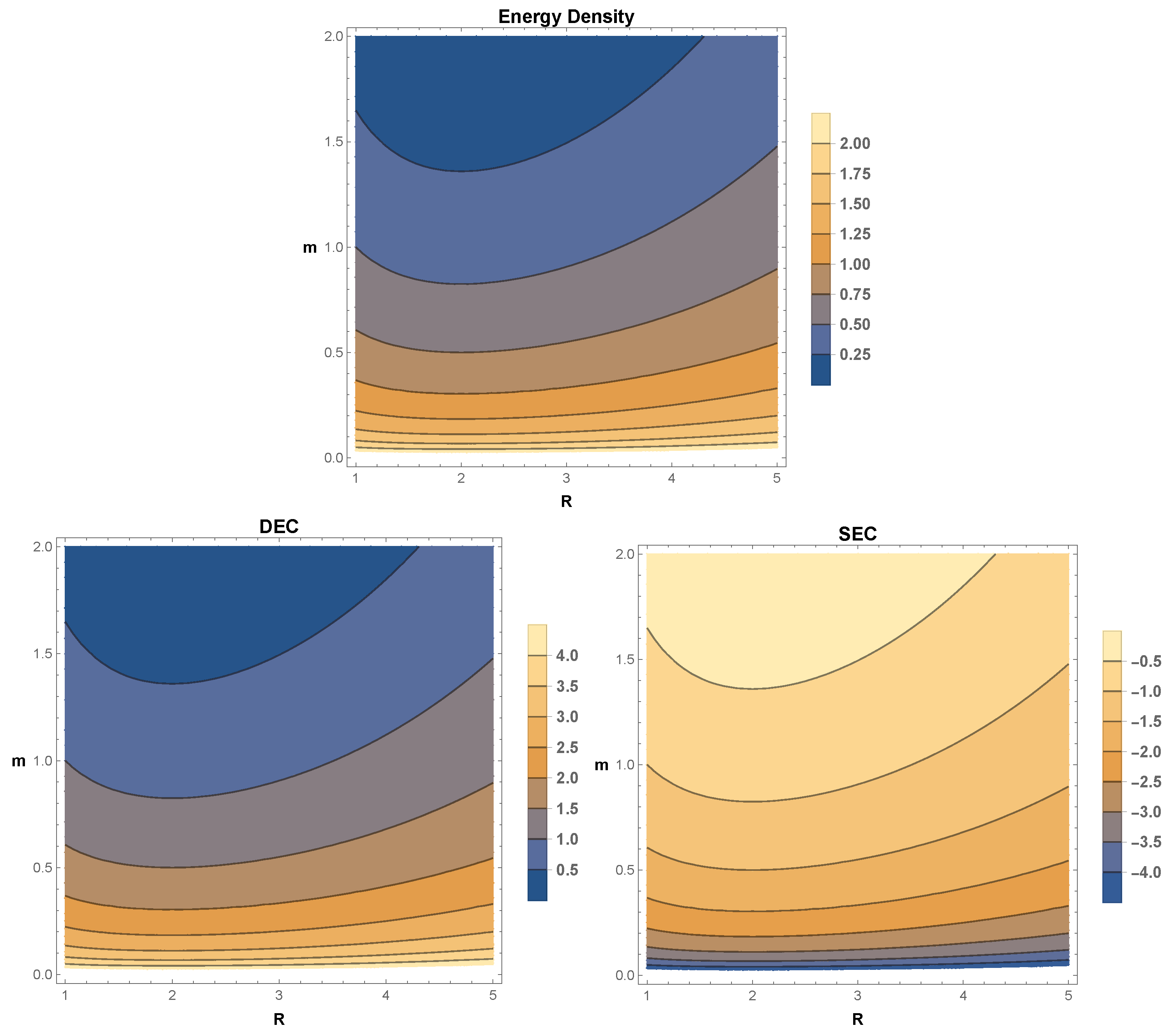Ricci Semi-Symmetric Robertson–Walker Spacetime in f(R)-Gravity
Abstract
1. Introduction
2. -Spacetime
3. Characterization of Ricci Semi-Symmetric -Spacetime
- When , this condition leads to a spacetime characterized by a constant positive curvature, specifically classifying it as a de Sitter spacetime [36].
4. Ricci Semi-Symmetric -Spacetime Obeying -Gravity
5. Energy Conditions
- Null energy condition (NEC): if .
- Strong energy condition (SEC): if with .
- Weak energy condition (WEC): if , with .
- Dominant energy condition (DEC): if , .
6. Features of -Gravity Models
6.1. Model-1:
6.2. Model-2:
6.3. Model-3:
7. Discussion
Author Contributions
Funding
Data Availability Statement
Acknowledgments
Conflicts of Interest
References
- Chen, B.Y. A simple characterization of generalized Robertson–Walker spacetimes. Gen. Relativ. Gravit. 2014, 46, 1833. [Google Scholar] [CrossRef]
- Mantica, C.; Molinari, L. Generalized Robertson—Walker spacetimes—A survey. Int. Geom. Methods Mod. Phys. 2017, 14, 1730001. [Google Scholar] [CrossRef]
- Mantica, C.; Molinari, L. On the Weyl and Ricci tensors of Generalized Robertson-Walker space-times. J. Math. Phys. 2016, 57, 102502. [Google Scholar] [CrossRef]
- Mantica, C.; Molinari, L.; Suh, Y.; Shenawy, S. Perfect-Fluid, Generalized Robertson-Walker Space-times, and Gray’s Decomposition. J. Math. Phys. 2019, 60, 52506. [Google Scholar] [CrossRef]
- Mantica, C.; De, U.; Suh, Y.J.; Molinari, L. Perfect fluid spacetimes with harmonic generalized curvature tensor. Osaka J. Math. 2019, 56, 173–182. [Google Scholar]
- Sanchez, M. On the geometry of generalized Robertson-Walker spacetimes: Geodesics. Gen. Relativ. Gravit. 1998, 30, 915–932. [Google Scholar] [CrossRef]
- Capozziello, S.; Mantica, C.; Molinari, L. Cosmological perfect fluids in f(R) gravity. Int. J. Geom. Methods Mod. Phys. 2019, 16, 1950008. [Google Scholar] [CrossRef]
- Chaki, M. On generalized quasi Einstein manifolds. Publ. Math. Debr. 2001, 58, 683–691. [Google Scholar] [CrossRef]
- Buchdahl, H. Non-linear Lagrangians and cosmological theory. Mon. Not. R. Astron. Soc. 1970, 150, 1–8. [Google Scholar] [CrossRef]
- Nojiri, S.; Odintsov, S. Modified gravity with negative and positive powers of the curvature. Phys. Rev. D 2003, 68, 123512. [Google Scholar] [CrossRef]
- Carroll, S.M.; Duvvuri, V.; Trodden, M.; Turner, M.S. Is cosmic speed-up due to new gravitational physics? Phys. Rev. D 2004, 70, 043528. [Google Scholar] [CrossRef]
- De, A.; How, L.; Arora, S.; Sahoo, P. Energy conditions for a (WRS)4-spacetime in F(R)-gravity. Eur. Phys. J. Plus 2021, 136, 218. [Google Scholar] [CrossRef]
- De, A.; Loo, T.H.; Solanki, R.; Sahoo, P.K. A conformally flat generalized Ricci recurrent spacetime in f(R)-gravity. Phys. Scr. 2021, 96, 138–147. [Google Scholar] [CrossRef]
- De, A.; Arora, S.; De, U.C.; Sahoo, P. A complete study of conformally flat pseudo-symmetric spacetimes in the theory of f(R)-gravity. Results Phys. 2022, 32, 105053. [Google Scholar] [CrossRef]
- Santos, J.; Alcaniz, J.S.; Reboucas, M.J.; Carvalho, F.C. Energy conditions in f(R) gravity. Phys. Rev. D 2007, 76, 083513. [Google Scholar] [CrossRef]
- Cardone, V.; Capozziello, S.; Francaviglia, M. f(R) Theories of Gravity in Palatini Approach Matched with Observations. Gen. Relativ. Grav. 2006, 38, 33–60. [Google Scholar]
- Astashenok, A.V.; Capozziello, S.; Odintsov, S.D. Maximal neutron star mass and the resolution of the hyperon puzzle in modified gravity. Phys. Rev. D 2014, 89, 103509. [Google Scholar] [CrossRef]
- Astashenok, A.V.; Capozziello, S.; Odintsov, S.D. Further stable neutron star models from f(R) gravity. J. Cosmol. Astropart. Phys. 2013, 12, 40. [Google Scholar] [CrossRef]
- Astashenok, A.V.; Odintsov, S.D.; De la Cruz-Dombriz, A. The realistic models of relativistic stars in f(R) = R + αR2 gravity. Class. Quant. Grav. 2017, 34, 205008. [Google Scholar] [CrossRef]
- Astashenok, A.V. Neutron and quark stars in f(R) gravity. Int. J. Mod. Phys. Conf. Ser. 2016, 41, 1660130. [Google Scholar] [CrossRef]
- Perez Bergliaffa, S. Constraining f(R) theories with the energy conditions. Phys. Lett. B 2006, 642, 311–314. [Google Scholar] [CrossRef]
- Hawking, S.; Ellis, G. The Large Scale Structure of Spacetime; Cambridge University Press: Cambridge, UK, 1973. [Google Scholar]
- De, U.; Suh, Y.; Chaubey, S. Semi-Symmetric Curvature Properties of Robertson–Walker Spacetimes. J. Math. Phys. Anal. Geom. 2022, 18, 368–381. [Google Scholar]
- Banerjee, A.; Jasim, M.; Ghosh, S.G. Wormholes in f (R, T) gravity satisfying the null energy condition with isotropic pressure. Ann. Phys. 2021, 433, 168575. [Google Scholar] [CrossRef]
- Singh, J.; Balhara, H.; Bamba, K.; Jena, J. Bouncing cosmology in modified gravity with higher-order curvature terms. J. High Energy Phys. 2023, 2023, 1–21. [Google Scholar] [CrossRef]
- Gadbail, G.N.; Kolhatkar, A.; Mandal, S.; Sahoo, P. Correction to Lagrangian for bouncing cosmologies in f (Q) gravity. Eur. Phys. J. C 2023, 83, 595. [Google Scholar] [CrossRef]
- Sharif, M.; Waseem, A. Study of isotropic compact stars in gravity. Eur. Phys. J. Plus 2016, 131, 190. [Google Scholar] [CrossRef]
- Mandal, S.; Pradhan, S.; Sahoo, P.; Harko, T. Cosmological observational constraints on the power law f (Q) type modified gravity theory. Eur. Phys. J. C 2023, 83, 1141. [Google Scholar] [CrossRef]
- Solanki, R.; Rana, D.S.; Mandal, S.; Sahoo, P.K. Viscous fluid cosmology in symmetric teleparallel gravity. Fortschr. Phys. 2023, 71, 2200202. [Google Scholar] [CrossRef]
- Das, S.; Mandal, S. f (Q,T) gravity: From early to late-time cosmic acceleration. Indian J. Phys. 2024, 1–16. [Google Scholar] [CrossRef]
- Feng, Y.; Naseer, T.; Ashraf, A.; Sofuoğlu, D.; Abdullayeva, I. A Brief analysis of isotropic Karmarkar models in modified gravity theory. Chin. J. Phys. 2024, 90, 372–386. [Google Scholar] [CrossRef]
- Abbas, G.; Majeed, K. Isotropic gravastar model in Rastall gravity. Adv. Astron. 2020, 2020, 8861168. [Google Scholar] [CrossRef]
- Maurya, S.; Errehymy, A.; Singh, K.N.; Donmez, O.; Nisar, K.S.; Mahmoud, M. Self-bound isotropic models in f (Q) gravity and effect of f (Q) parameter on mass–radius relation and stability of compact objects. Phys. Dark Universe 2024, 46, 101619. [Google Scholar] [CrossRef]
- Singh, J.; Balhara, H.; Bamba, K.; Jena, J. Cosmic analysis of a model in higher-order gravity theory. Astron. Comput. 2024, 46, 100790. [Google Scholar] [CrossRef]
- Naicker, S.; Maharaj, S.D.; Brassel, B.P. Isotropic perfect fluids in modified gravity. Universe 2023, 9, 47. [Google Scholar] [CrossRef]
- Duggal, K.; Sharma, R. Symmetries of Spacetimes and Riemannian Manifolds; Springer Science & Business Media: Berlin/Heidelberg, Germany, 1999. [Google Scholar]
- Sotiriou, T.; Faraoni, V. f(R) theories of gravity. Rev. Mod. Phys. 2010, 82, 451–497. [Google Scholar] [CrossRef]
- Benetti, M.; Capozziello, S.; Graef, L. Swampland conjecture in f(R) gravity by the Noether symmetry approach. Phys. Rev. D 2019, 100, 084013. [Google Scholar] [CrossRef]
- Lima, M.; Vitenti, S.; Reboucas, M. Revisiting the Confrontation of the Energy Conditions Bounds with Supernovae Data. Astron. Relativ. Astrophys. 2007, 213–217. [Google Scholar] [CrossRef]
- Raychaudhuri, A. Relativistic Cosmology. Phys. Rev. 1955, 98, 1123. [Google Scholar] [CrossRef]
- Ehlers, J. A. K. Raychaudhuri and his equations. Int. J. Mod. Phys. D 2006, 15, 1573–1580. [Google Scholar] [CrossRef]
- Moraes, P.H.R.S.; Sahoo, P.K. The simples non-minimal matter-geometry coupling in the f(R, T) cosmology. Eur. Phys. J. C. 2017, 77, 480. [Google Scholar] [CrossRef]
- Wald, R. General Relativity; University of Chicago Press: Chicago, IL, USA, 1984. [Google Scholar]
- Starobinsky, A.A. A new type of isotropic cosmological models without singularity. Phys. Lett. B 1980, 91, 99–102. [Google Scholar] [CrossRef]
- De Felice, A.; Tsujikawa, S. f(R) theories. Living Rev. Relativ. 2010, 13, 1–161. [Google Scholar]
- Ntahompagaze, J.; Abebe, A.; Mbonye, M. On f(R) gravity in scalar–tensor theories. Int. J. Geom. Methods Mod. Phys. 2017, 14, 1750107. [Google Scholar] [CrossRef]
- Odintsov, S.; Oikonomou, V. Singular inflationary universe from F (R) gravity. Phys. Rev. D 2015, 92, 124024. [Google Scholar] [CrossRef]
- Gogoi, D.J.; Dev Goswami, U. A new f (R) gravity model and properties of gravitational waves in it. Eur. Phys. J. C 2020, 80, 1101. [Google Scholar] [CrossRef]
- Mandal, S.; Sahoo, P.K. A Complete Cosmological Scenario in Teleparallel Gravity. Eur. Phys. J. Plus 2020, 135, 760. [Google Scholar] [CrossRef]
- Mandal, S.; De, A.; Loo, T.H.; Sahoo, P.K. Almost-Pseudo-Ricci Symmetric FRW Universe with a Dynamic Cosmological Term and Equation of State. Universe 2021, 7, 205. [Google Scholar] [CrossRef]
- Aghanim, N.; Akrami, Y.; Ashdown, M.; Aumont, J.; Baccigalupi, C.; Ballardini, M.; Banday, A.J.; Barreiro, R.B.; Bartolo, N.; Basak, S.; et al. Planck 2018 results-VI. Cosmological parameters. Astron. Astrophys. 2020, 641, A6. [Google Scholar]
- Sahoo, P.K.; Mandal, S.; Arora, S. Energy conditions in non-minimally coupled f (R, T) gravity. Astron. Nachrichten 2021, 342, 89–95. [Google Scholar] [CrossRef]
- Zhadyranova, A.; Koussour, M.; Bekkhozhayev, S.; Zhumabekova, V.; Rayimbaev, J. Exploring late-time cosmic acceleration: A study of a linear f (T) cosmological model using observational data. Phys. Dark Universe 2024, 45, 101514. [Google Scholar] [CrossRef]
- Koussour, M.; Shekh, S.; Bennai, M. Cosmic acceleration and energy conditions in symmetric teleparallel f(Q) gravity. J. High Energy Astrophys. 2022, 35, 43–51. [Google Scholar]
- Tsujikawa, S. Observational signatures of f(R) dark energy models that satisfy cosmological and local gravity constraints. Phys. Rev. D 2008, 77, 023507. [Google Scholar]
- Appleby, S.; Battye, R. Do consistent f(R) models mimic general relativity plus. Phys. Lett. B 2007, 7, 654. [Google Scholar]
- Loo, T.H.; De, A.; Mandal, S.; Sahoo, P. How a projectively flat geometry regulates F (R)-gravity theory? Phys. Scr. 2021, 96, 125034. [Google Scholar]
- Cai, R.G.; Wang, A. Black hole formation from collapsing dust fluid in a background of dark energy. Phys. Rev. D Part. Fields Gravit. Cosmol. 2006, 73, 063005. [Google Scholar]
- Shah, H.H.; Rahaman, F.; Ali, A.; Molla, S. Gravitational collapse of an interacting vacuum energy density with an anisotropic fluid. Phys. Dark Universe 2019, 24, 100291. [Google Scholar]



Disclaimer/Publisher’s Note: The statements, opinions and data contained in all publications are solely those of the individual author(s) and contributor(s) and not of MDPI and/or the editor(s). MDPI and/or the editor(s) disclaim responsibility for any injury to people or property resulting from any ideas, methods, instructions or products referred to in the content. |
© 2025 by the authors. Licensee MDPI, Basel, Switzerland. This article is an open access article distributed under the terms and conditions of the Creative Commons Attribution (CC BY) license (https://creativecommons.org/licenses/by/4.0/).
Share and Cite
Kumara, H.A.; Haseeb, A.; Venkatesha, V.; Bilal, M. Ricci Semi-Symmetric Robertson–Walker Spacetime in f(R)-Gravity. Mathematics 2025, 13, 1012. https://doi.org/10.3390/math13061012
Kumara HA, Haseeb A, Venkatesha V, Bilal M. Ricci Semi-Symmetric Robertson–Walker Spacetime in f(R)-Gravity. Mathematics. 2025; 13(6):1012. https://doi.org/10.3390/math13061012
Chicago/Turabian StyleKumara, H. Aruna, Abdul Haseeb, V. Venkatesha, and Mohd Bilal. 2025. "Ricci Semi-Symmetric Robertson–Walker Spacetime in f(R)-Gravity" Mathematics 13, no. 6: 1012. https://doi.org/10.3390/math13061012
APA StyleKumara, H. A., Haseeb, A., Venkatesha, V., & Bilal, M. (2025). Ricci Semi-Symmetric Robertson–Walker Spacetime in f(R)-Gravity. Mathematics, 13(6), 1012. https://doi.org/10.3390/math13061012






